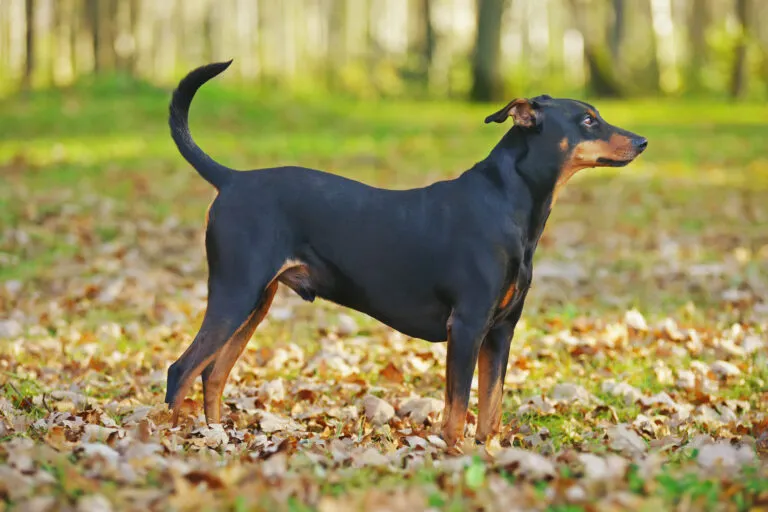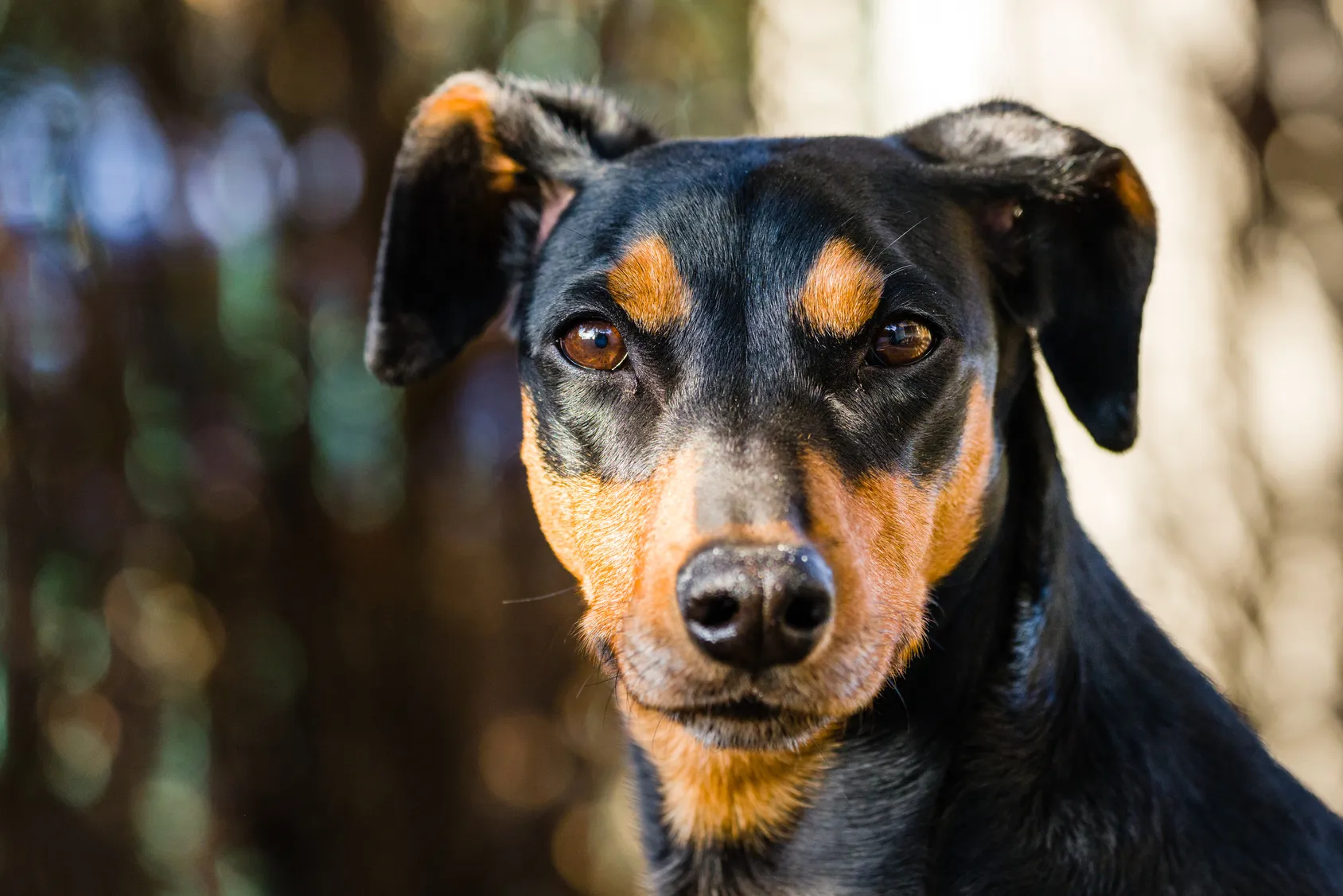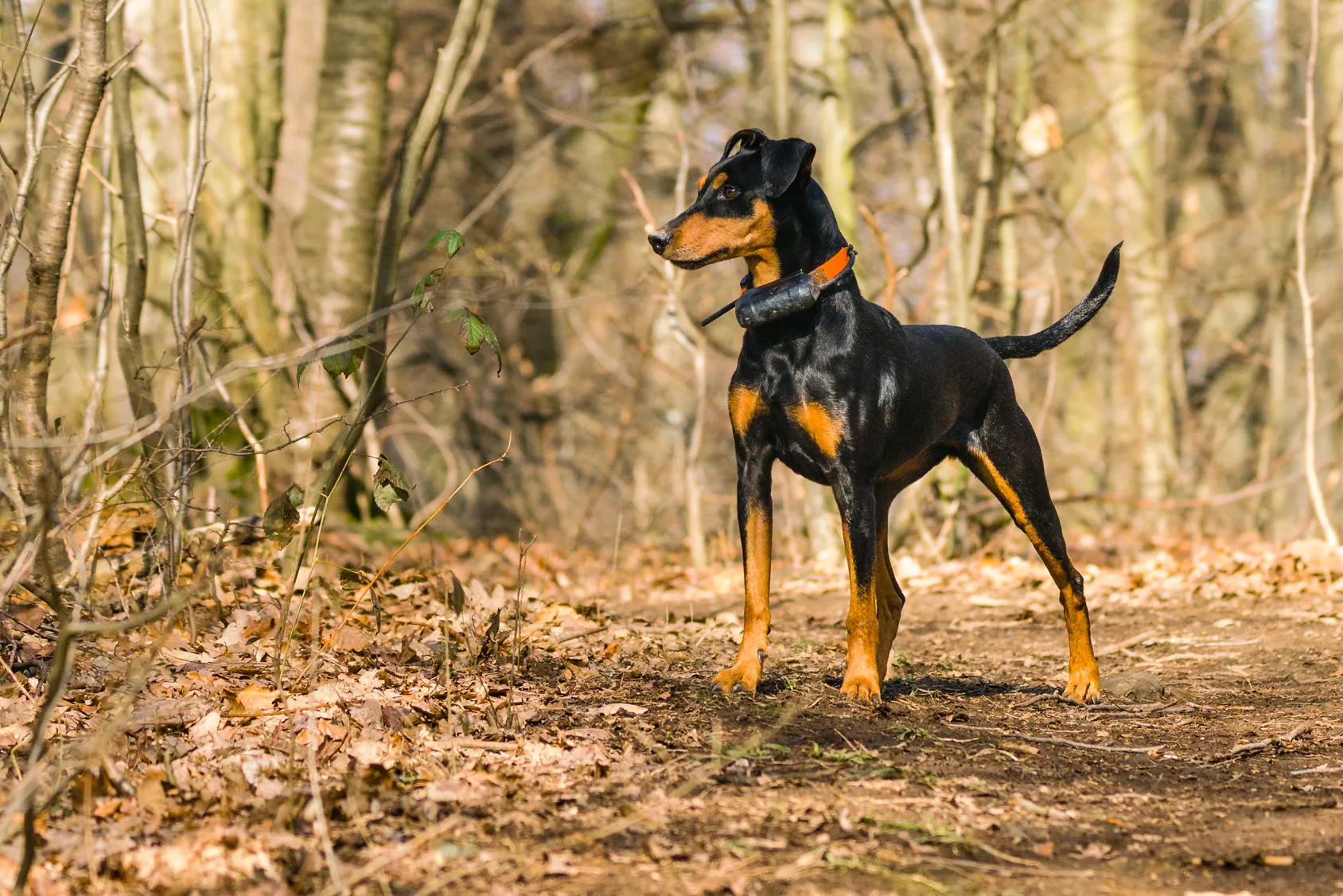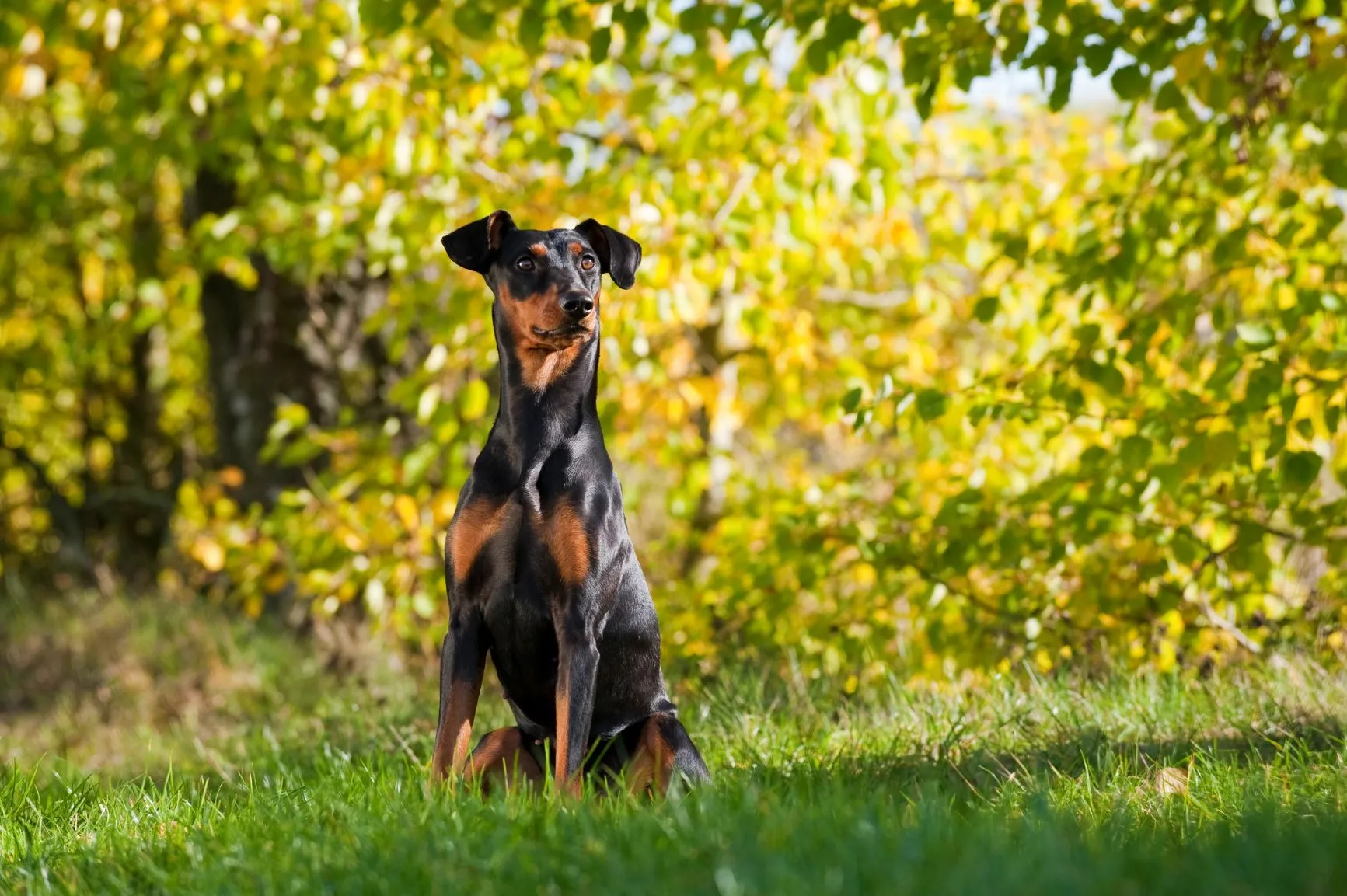Beagle
The Beagle's short legs can be deceiving – this medium-sized dog keeps you on your toes and is always full of surprises! This friendly breed is active, fearless and extremely clever.
Once king of the castle at practically every farm and a popular stable dog and rat catcher, more than anything else, the strong-willed German Pinscher wants to get stuck into everything.

© Eudyptula / stock.adobe.com
The German Pinscher is a strong character and very active four-legged friend.
German Pinschers are known to be spirited and active dogs with a tendency to be affectionate and cuddly. Whilst outside, this dog’s playfulness and urge to run around know no bounds. However, as soon as this clever, confident creature is back at home, all it wants is cuddles!
Whether inside your own four walls or outside in the open air, these dogs demand all of their owners’ attention. However, this does not mean that the German Pinscher wants to be controlled by its owner. Quite the contrary, the Pinscher knows its own mind and can decide for itself exactly what it wants. These intelligent, independent creatures need their own space, both physically and emotionally. These dogs have a firm grasp on their territory and pack, thanks to their inherent self-confidence and intelligence. As a former farm dog, German Pinschers are extremely vigilant and love watching over their home. They are quick to report anything unusual occurring – strangers cannot enter the home of a German Pinscher unnoticed! However, this spirited yet calm, well-balanced breed is anything but a “yapper”, using its bark only sparingly.
Although strangers are treated with slight mistrust, German Pinschers are faithful and loving companions to their family. With the kind yet firm, structured training and a confident leader, this breed can be extremely adaptable and obedient. The deciding factor is whether it can fully comprehend its owner’s instructions. Pinschers will learn only what it deems necessary, showing you exactly how it feels about things they don’t like! This dog innately knows how to put its intelligence to good use. It will instantly recognise any weaknesses in its handler and knows how to use these failings to its own advantage. This shrewd disobedience can present a challenge even to an experienced dog handler. Observing set training rules from the outset can help to steer this stubborn breed in the desired direction. The German Pinscher makes for an amiable family or companion dog, thanks to its good-natured character, trainability and resilience.
 © Wolfgang / stock.adobe.com
© Wolfgang / stock.adobe.com
The German Pinscher’s short, tight fur is extremely easy to clean, making it the ideal family or household dog. The thick coat is smooth and glossy, primarily made up of a dark black with red markings. Some Pinschers are entirely red, although this number makes up just approximately 20% of the breed.
With a shoulder height of 45-50cm and weight of 14-20kg, the German Pinscher is neither “too small” nor “too big”. Its height and length are roughly equal. Its posture is proud and elegant, perfectly suiting its self-confident nature. It shows its strength and ability through its muscular body, which is particularly useful when running and playing. The strong back slopes slightly downwards towards the rear. It has V-shaped droopy ears, which sit high on the strong, elongated skull and fold forwards. The edges of the ears are very thin, which can easily lead to injuries in an otherwise extremely healthy dog.
The German Pinscher encounters very few canine illnesses, perhaps due to the fact that it has never been “over-bred”. The German Pinscher belongs to the oldest breed of dogs in Europe, along with dogs such as the Schnauzer. It is thought that they are the direct descendants of Peat Dogs, which experts believe were already around in the year 3000 BC. Where the breed originally came from is fairly unclear. Some researchers believe the Pinscher came from Wurttemberg, while others think it is a derivative of the English terrier. Yet more believe it is the other way around – that the English terrier is a descendant of the German Pinscher.
The German Pinscher’s appearance has changed very little over the years, thanks to its mention in the 1880 edition of the “German Stud Book” and presence in paintings from the Middle Ages and the Renaissance period.
At the turn of the century, the German Pinscher could be found on nearly every farm and estate. It would have had two main roles – firstly, to watch over the house and farm; secondly, to keep pests such as rats at bay. It was this versatility that distinguished the Pinscher from other dogs and made them vital assets. These early uses for the German Pinscher also brought it certain nicknames, such as “Stable Pinscher” and “Rattler”. It is also possible that the name “Pinscher” comes from this ability as a skilled rat catcher – the word meant “Beisser” [“biter”] in Old High German and may be linked to the English verb “to pinch”, related to the idea that they would catch the mice and rats by pinching them between their paws. Working as a ratter, the Pinscher would largely feed itself, which was another reason for its popularity.
The smooth-haired and the rough-haired Pinscher used to belong to the same breed, although now they are known as the German Pinscher and the Schnauzer respectively. The Pinscher Club, founded in 1895, cared for and bred both as one combined breed. Despite nowadays being recognised as two separate breeds, they are managed collectively by the Pinscher-Schnauzer Club 1895 Registered Association.
It was only in the 20th century that the rough-haired Schnauzer and the smooth-haired Pinscher were finally separated into different breeds, as up until then they were still to be found together in one litter. In 1917, the rough-haired Pinscher was officially renamed as the Schnauzer and, at the same time, the Miniature Pinscher was officially deemed to be a separate breed from its larger counterpart. Unlike the Schnauzer and Miniature Pinscher, the German Pinscher lost a great deal of popularity at this time. Additionally, the start of industrialisation meant that many former stable owners and coach drivers became unemployed, as the horse and cart was gradually replaced by motorised vehicles. Similarly, the German Pinscher began to disappear from the picture.
Fortunately, the breeder Werner Jung took on the almost extinct breed in the mid-1950s, chancing bringing a new breed of the smooth-haired Pinscher to the Pinscher-Schnauzer Club in 1958. Jung succeeded in ensuring the continued existence of the German Pinscher with the Pinscher bitch, “Kitti vom Bodenstrand”, and the oversized Miniature Pinschers, “Jutta Jung”, “Illo Fischer”, “Fürst Jung” and “Onzo Illgen”. Nevertheless, to this day the German Pinscher remains a rare breed. Between 1998 and 2003, just 160-220 puppies were born each year, and in 2003 the German Pinscher was placed on the list of endangered pet breeds.
 © Wolfgang / stock.adobe.com
© Wolfgang / stock.adobe.com
For many dog lovers, this statistic was a wake-up call, causing the number of new breeders to increase after 2003.
As the German Pinscher has never been “over-bred” in mass quantities, it remains a very healthy breed of dog and has generally been spared from hereditary diseases. This means that only the test for hip dysplasia is compulsory; other checks for illnesses such as hereditary eye diseases (colour defects) and von Willbrand disease (haemophilia) are voluntary. Aside for mandatory examinations and vaccinations, visits to the vet are rare for owners of German Pinschers.
 © DoraZett / stock.adobe.com
© DoraZett / stock.adobe.com
Something that requires significantly more work, however, is exercising this breed of dog, as well as its often-obstinate character. As former guarding and hunting dogs that kept watch over their house and farm, the German Pinscher tends to remain a fairly dominant breed. This means that German Pinschers may not necessarily be suitable for families with small children, despite this dog’s playful nature. Above all, it needs an experienced owner who will take charge and relieve it of its original task of monitoring strangers in and around the house. The German Pinscher needs clear boundaries with its training. In order to learn its new purpose, the owner needs to be assertive and bring intelligence, creativity and self-assurance to the table.
Physical exercise is also crucial if you are hoping to raise a dog that is well-balanced, able to relax and does not make up its own rules, which is why the active and spirited German Pinscher is most suited to sporty people who want to get actively involved with their dog. The German Pinscher makes the ideal partner for any recreational sport, including cycling, horse riding and jogging. Dog agility and tournaments are also great fun for your dog. Tasks such as tracking and mantrailing can help to exercise your dog mentally, something that is also extremely important in keeping your German Pinscher happy. Its charming nature means that the Pinscher can always convince its owner to run with it, play with it or go for invigorating walks. After such vigorous outdoor activity in the fresh air, you can look forward to returning home with an extremely cuddly, affectionate dog!
If you are looking for an intensive physical and mental dog-owner relationship and are looking for an active, affectionate dog, then look no further than the German Pinscher!
The Beagle's short legs can be deceiving – this medium-sized dog keeps you on your toes and is always full of surprises! This friendly breed is active, fearless and extremely clever.
The Golden Retriever is still one of the most popular dog breeds, especially with families. It is defined not just by its docility, but shows numerous other qualities too. Read in the following article everything you need to know about the Golden Retriever.
The German Shepherd is one of the most popular utility dog breeds in the world, though the willing-to-learn and people-focused nature of these versatile dogs also makes them suitable for family life.